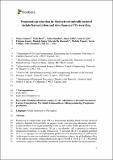| dc.contributor.author | Isipato, Marco | |
| dc.contributor.author | Dessì, Paolo | |
| dc.contributor.author | Sánchez, Carlos | |
| dc.contributor.author | Mills, Simon | |
| dc.contributor.author | Ijaz, Umer Z. | |
| dc.contributor.author | Asunis, Fabiano | |
| dc.contributor.author | Spiga, Daniela | |
| dc.contributor.author | De Gioannis, Giorgia | |
| dc.contributor.author | Mascia, Michele | |
| dc.contributor.author | Collins, Gavin | |
| dc.contributor.author | Muntoni, Aldo | |
| dc.contributor.author | Lens, Piet N. L. | |
| dc.date.accessioned | 2021-01-18T11:39:02Z | |
| dc.date.available | 2021-01-18T11:39:02Z | |
| dc.date.issued | 2020-12-15 | |
| dc.identifier.citation | Isipato, Marco, Dessì, Paolo, Sánchez, Carlos, Mills, Simon, Ijaz, Umer Z., Asunis, Fabiano, Spiga,Daniela De Gioannis, Giorgia, Mascia,Michele, Collins,Gavin, Muntoni, Aldo, Lens, Piet N. L. (2020). Propionate Production by Bioelectrochemically-Assisted Lactate Fermentation and Simultaneous CO2 Recycling. Frontiers in Microbiology, 11(3184). doi:10.3389/fmicb.2020.599438 | en_IE |
| dc.identifier.issn | 1664-302X | |
| dc.identifier.uri | http://hdl.handle.net/10379/16460 | |
| dc.description.abstract | Production of volatile fatty acids (VFAs), fundamental building blocks for the chemical industry, depends on fossil fuels but organic waste is an emerging alternative substrate. Lactate produced from sugar-containing waste streams can be further processed to VFAs. In this study, electrofermentation (EF) in a two-chamber cell is proposed to enhance propionate production via lactate fermentation. At an initial pH of 5, an applied potential of −1 V vs. Ag/AgCl favored propionate production over butyrate from 20 mM lactate (with respect to non-electrochemical control incubations), due to the pH buffering effect of the cathode electrode, with production rates up to 5.9 mM d–1 (0.44 g L–1 d–1). Microbial community analysis confirmed the enrichment of propionate-producing microorganisms, such as Tyzzerella sp. and Propionibacterium sp. Organisms commonly found in microbial electrosynthesis reactors, such as Desulfovibrio sp. and Acetobacterium sp., were also abundant at the cathode, indicating their involvement in recycling CO2 produced by lactate fermentation into acetate, as confirmed by stoichiometric calculations. Propionate was the main product of lactate fermentation at substrate concentrations up to 150 mM, with a highest production rate of 12.9 mM d–1 (0.96 g L–1 d–1) and a yield of 0.48 mol mol–1 lactate consumed. Furthermore, as high as 81% of the lactate consumed (in terms of carbon) was recovered as soluble product, highlighting the potential for EF application with high-carbon waste streams, such as cheese whey or other food wastes. In summary, EF can be applied to control lactate fermentation toward propionate production and to recycle the resulting CO2 into acetate, increasing the VFA yield and avoiding carbon emissions and addition of chemicals for pH control. | en_IE |
| dc.description.sponsorship | This work was funded by the Science Foundation of Ireland (SFI) Research Professorship Programme on Innovative Energy Technologies for Bioenergy, Biofuels and a Sustainable Irish Bioeconomy (IETSBIO3, award 15/RP/2763) and the Research Infrastructure research grant Platform for Biofuel Analysis (Grant Number 16/RI/3401). GC and SM were supported by a European Research Council Starting Grant (3C-BIOTECH 261330). GC was supported by an SFI Career Development Award (17/CDA/4658). | en_IE |
| dc.format | application/pdf | en_IE |
| dc.language.iso | en | en_IE |
| dc.publisher | Frontiers Media | en_IE |
| dc.relation.ispartof | Frontiers In Microbiology | en |
| dc.rights | Attribution-NonCommercial-NoDerivs 3.0 Ireland | |
| dc.rights.uri | https://creativecommons.org/licenses/by-nc-nd/3.0/ie/ | |
| dc.subject | Propionate Production by Bioelectrochemically-Assisted Lactate Fermentation and Simultaneous CO2 Recycling | en_IE |
| dc.subject | Bioelectrochemically-Assisted Lactate Fermentation | en_IE |
| dc.subject | Simultaneous CO2 Recycling | en_IE |
| dc.title | Propionate production by bioelectrochemically-assisted lactate fermentation and simultaneous CO2 recycling | en_IE |
| dc.type | Article | en_IE |
| dc.date.updated | 2021-01-14T15:45:25Z | |
| dc.identifier.doi | 10.3389/fmicb.2020.599438 | |
| dc.local.publishedsource | https://doi.org/10.3389/fmicb.2020.599438 | en_IE |
| dc.description.peer-reviewed | peer-reviewed | |
| dc.contributor.funder | Science Foundation Ireland | en_IE |
| dc.contributor.funder | European Research Council | en_IE |
| dc.internal.rssid | 24366372 | |
| dc.local.contact | Paolo Dessi. Email: paolo.dessi@nuigalway.ie | |
| dc.local.copyrightchecked | Yes | |
| dc.local.version | ACCEPTED | |
| dcterms.project | info:eu-repo/grantAgreement/EC/FP7::SP2::ERC/261330/EU/Cold Carbon Catabolism of Microbial Communities underprinning a Sustainable Bioenergy and Biorefinery Economy/3CBIOTECH | en_IE |
| nui.item.downloads | 115 | |


